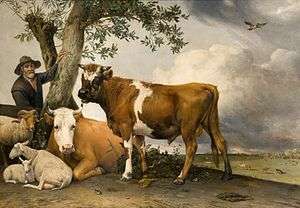The Young Bull
The Young Bull[1] (Dutch: De jonge stier)[2] or The Bull[3] (Dutch: De stier)[4] is an oil painting of a bull by Paulus Potter. It is in the collection of the Mauritshuis in The Hague in the Netherlands.
| The Young Bull | |
|---|---|
| Dutch: De stier | |
 | |
| Artist | Paulus Potter |
| Year | 1647 |
| Medium | Oil on canvas |
| Subject | Bull |
| Dimensions | 235.5 cm × 339 cm (92.7 in × 133 in) |
| Location | Mauritshuis, The Hague, Netherlands |
At about life-size, this is an unusually monumental animal painting that challenges the hierarchy of genres by its almost heroic treatment of an animal.[3][5] The large size allows space for very detailed realism, including flies, that was both admired and criticised, especially in the 19th century.[6]
The painting is signed and dated 1647,[3] meaning that Potter, who was born in November 1625, was only 22 when he completed it; he died in 1654, before he reached 30.[7] The painting was highly admired in the 18th and 19th centuries; in the 1870s the French artist and critic Eugène Fromentin asserted confidently that it, Rembrandt's The Night Watch and his The Anatomy Lesson of Dr. Nicolaes Tulp (also in the Mauritshuis) were the three most famous paintings in the Netherlands.[8]
The painting was enlarged by Potter, who added extra strips of canvas on both sides and at the top to his original composition, which just included the bull itself.[9] The village in the background is Rijswijk, between Delft and The Hague.[10] Though paintings of animals in landscape were Potter's speciality, this is the largest apart from his single life-size equestrian portrait, and most are far smaller.[11]
The bull was a symbol of prosperity to the Dutch, hitherto overlooked in art, and apart from the horse by far the most commonly shown animal in Dutch Golden Age painting; goats were used to indicate Italy. This is an enormous and famous portrait which was in the Prince William V Gallery collection that Napoleon took to Paris in 1795 and through a later treaty was returned in 1815. It hung in the Louvre for 20 years. Livestock analysts have noted from the depiction of the various parts of the anatomy that it appears to be a composite of studies of six different animals of widely different ages.[12]
Like the equally life-size bird in Jan Asselijn's The Threatened Swan (1650), the bull can also function as a symbol of the Dutch Republic.[13] Probably not until Whistlejacket, a painting of an English racehorse of a century later, is an equally monumental animal portrait to be found.
Notes
- as per Slive, 208-10, Getty Museum biography, Walsh, MacLaren, 314
- (in Dutch) Fotoreproductie van een schilderij van Paulus Potter, 'De [jonge] stier' (coll. Mauritshuis), Adolphe Braun et Cie, 1886, Rijksmuseum. Retrieved on 4 May 2015.
- The Bull, Mauritshuis. Retrieved on 11 December 2014.
- (in Dutch) De stier, Mauritshuis. Retrieved on 11 December 2014.
- Walsh; Slive, 208-10
- Walsh; Slive, 208-10
- MacLaren, 313; Slive, 210
- Fromentin, 117. Coincidentally, Tulp was a patron of Potter, and Potter's equestrian portrait depicted his son Dirck Tulp.
- Potter
- Walsh
- MacLaren, 314
- Potter; Slive, 208-10
- Paulus Potter. "A Young Bull and two Cows in a Meadow". Royal Collection Trust. Inventory no. 404585.
References
- Fromentin, Eugène, Les Maîtres d'autrefois, 1876, translated as "The Masters of Past Time", Phaidon, 1981, ISBN 071482142X
- MacLaren, Neil, The Dutch School, 1600–1800, Volume I, 1991, National Gallery Catalogues, National Gallery, London, ISBN 0947645993
- Potter, Polxeni, "The Bull (detail), 1647, By Paulus Potter (1625-1654)". Emerg Infect Dis [serial on the Internet]. 2001 Jan-Feb, accessed 3 May 2015, DOI: 10.3201/eid0701.AC0701
- Slive, Seymour, Dutch Painting, 1600–1800, Yale UP, 1995,ISBN 0300074514
- Walsh, Amy L., "Potter (i)." Grove Art Online, Oxford Art Online. Oxford University Press. Web. 3 May. 2015. subscription required
Further reading
- Simon Schama. The Embarrassment of Riches: An Interpretation of Dutch Culture in the Golden Age (1987)
External links

- The Bull at the Mauritshuis website